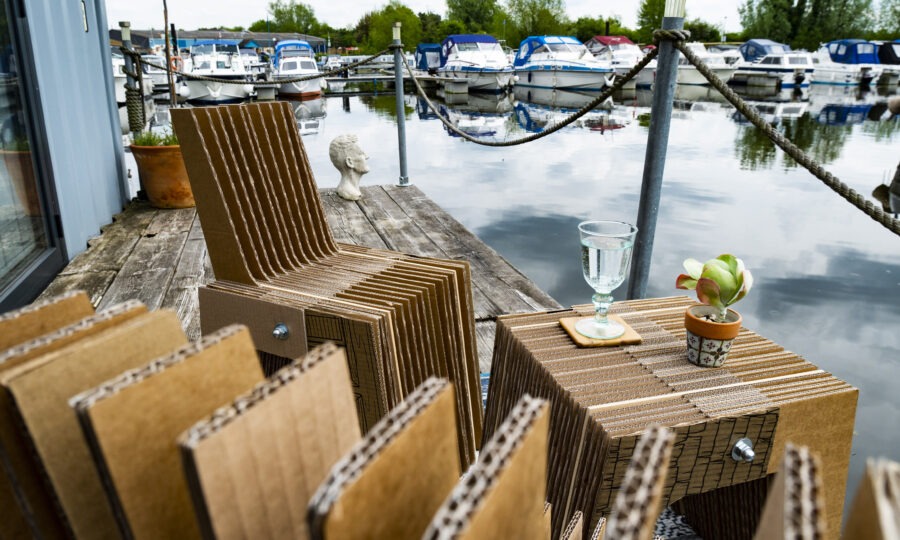Upcycling expert Max McMurdo has partnered with Beyond the Box to create a stylish set of garden furniture using the UK’s sustainable packaging material, cardboard.
Designing and making two modular chairs and a table to be used in the garden – or, in Max’s case, on the deck of his houseboat made from an old shipping container – Max used a selection of repurposed cardboard to produce his final pieces.
From designing the template to cutting out 180 shapes needed for the table and chairs, Max has created an al-fresco dining set capable of seating the average adult, using cardboard connected with a single rod and bolts.
“While this project might seem like a challenge to start with, cardboard is a fantastic material to use for upcycling,” explains Max, who has featured on BBC’s Dragons’ Den and Channel 4’s Amazing Spaces with his impressive upcycling creations.
“Cardboard is an amazing and underrated material. As well as its brilliant eco creds, the corrugation makes it really strong and structurally sound. Plus, it’s something we all have knocking around the house – from online shopping to takeaway pizza boxes, I’m sure we all have plenty of it at home post-lockdown!”
With households across the UK already re-using their abundance of cardboard boxes in numerous ways – from storage boxes to pet beds or just saving them for moving house – the cardboard campaign group, Beyond the Box, challenged Max to inspire the nation to re-think the way they use cardboard around the home and use the material to craft their own designs.
MAX’S TOP TIPS FOR UPCYCLING WITH CARDBOARD
- Invest in your tools
“One of the great things about cardboard is it is free and easily accessible, as it packages so many of the deliveries you’ll already have coming into your home. This means you can spend your money on a set of tools which you can use for future projects as well. I’d recommend a cardboard ruler and knife which is designed specially to cut cardboard so you don’t waste any material.”
- Plan plan plan!
“From creating your templates to making sure you’ve got enough cardboard and measuring out everything before you start cutting, planning out your design first will make it easier in the long run. If you choose a simple design, you should be able to cut out identical copies of each shape to attach together – I used 180 individual pieces for each of my objects.”
- Work with the cardboard
“Let the cardboard guide you and use its structure when you’re designing your piece. Make sure you use the corrugated fluting to your benefit as this is what gives cardboard its strength and structure.”
- Consider your joints
“Think about how you’re going to join everything together – and how long you want your design to last. I used a hole punch on every piece and threaded them together using a rod and finished with a bolt on each end – a bit like a giant cardboard kebab!”
- Have fun with it!
“Upcycling is all about playing around with different materials and finding what works for you. It’s a great project for kids to get stuck into, too. As well as the environmental benefit of reusing materials, it’s a fantastic way to unleash your creativity and add something unique to your home. And remember – if you decide to get rid of your object at any point, all the cardboard can be recycled (just remember to remove any nuts and bolts before you add it to the recycling!)”
For more tips on upcycling follow Max on Instagram. To find out more about the sustainable credentials of cardboard, follow Beyond the Box on Instagram or Facebook.
Cardboard is the UK’s sustainable packaging choice and is recyclable, renewable, reusable, and biodegradable.

